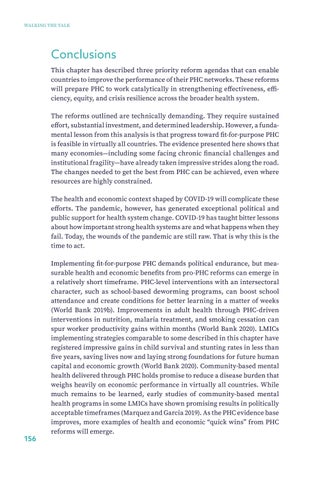WALKING THE TALK
Conclusions This chapter has described three priority reform agendas that can enable countries to improve the performance of their PHC networks. These reforms will prepare PHC to work catalytically in strengthening effectiveness, efficiency, equity, and crisis resilience across the broader health system. The reforms outlined are technically demanding. They require sustained effort, substantial investment, and determined leadership. However, a fundamental lesson from this analysis is that progress toward fit-for-purpose PHC is feasible in virtually all countries. The evidence presented here shows that many economies—including some facing chronic financial challenges and institutional fragility—have already taken impressive strides along the road. The changes needed to get the best from PHC can be achieved, even where resources are highly constrained. The health and economic context shaped by COVID-19 will complicate these efforts. The pandemic, however, has generated exceptional political and public support for health system change. COVID-19 has taught bitter lessons about how important strong health systems are and what happens when they fail. Today, the wounds of the pandemic are still raw. That is why this is the time to act.
156
Implementing fit-for-purpose PHC demands political endurance, but measurable health and economic benefits from pro-PHC reforms can emerge in a relatively short timeframe. PHC-level interventions with an intersectoral character, such as school-based deworming programs, can boost school attendance and create conditions for better learning in a matter of weeks (World Bank 2019b). Improvements in adult health through PHC-driven interventions in nutrition, malaria treatment, and smoking cessation can spur worker productivity gains within months (World Bank 2020). LMICs implementing strategies comparable to some described in this chapter have registered impressive gains in child survival and stunting rates in less than five years, saving lives now and laying strong foundations for future human capital and economic growth (World Bank 2020). Community-based mental health delivered through PHC holds promise to reduce a disease burden that weighs heavily on economic performance in virtually all countries. While much remains to be learned, early studies of community-based mental health programs in some LMICs have shown promising results in politically acceptable timeframes (Marquez and Garcia 2019). As the PHC evidence base improves, more examples of health and economic “quick wins” from PHC reforms will emerge.


